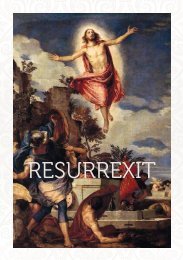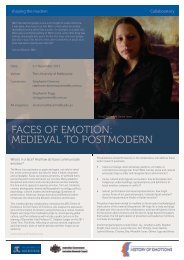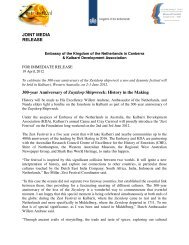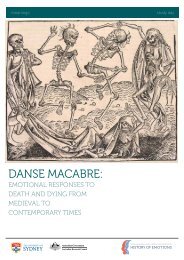Download our K-12 education pack - ARC Centre of Excellence for ...
Download our K-12 education pack - ARC Centre of Excellence for ...
Download our K-12 education pack - ARC Centre of Excellence for ...
You also want an ePaper? Increase the reach of your titles
YUMPU automatically turns print PDFs into web optimized ePapers that Google loves.
stories <strong>for</strong> teachers & students 2013<br />
Supporting Res<strong>our</strong>ces<br />
South Africa, Far from Home<br />
stories by winthrop pr<strong>of</strong>essor susan broomhall<br />
Emotions In Song: Melting-Pot Music<br />
in the ‘Smooth-Throated Nation’<br />
From the time <strong>of</strong> the arrivals <strong>of</strong> the Europeans to Africa, its<br />
varied peoples have been adapting and using new musical <strong>for</strong>ms<br />
to express their feelings and experiences.<br />
Many European observers noted the importance <strong>of</strong> dance and<br />
rhythm to the San people’s trance ceremonies, depicted in their<br />
rock art. Vasco da Gama recorded an early meeting with local<br />
peoples after successfully trading oxen and sheep, writing <strong>of</strong> how<br />
his hosts danced and ‘began to play on f<strong>our</strong> or five flutes, and<br />
some <strong>of</strong> them played high and others played low, harmonising<br />
together very well’. A French general who passed through the<br />
Cape in the early seventeenth century, Augustin de Beaulieu,<br />
wrote <strong>of</strong> the musicality <strong>of</strong> the speech <strong>of</strong> the Khoikhoi people :<br />
‘They speak from the throat, and seem to sob and sigh when<br />
speaking. Their usual greeting on meeting us is to dance a song,<br />
<strong>of</strong> which the beginning, the middle, and the end is ‘hautitou’.’<br />
This sound may be why Khoikhoi were <strong>of</strong>ten called by Europeans<br />
the ‘Hottentots,’ a name which both misunderstood their words<br />
and ignored their own name <strong>for</strong> themselves.<br />
Over time, local people adapted western instruments, such as<br />
the ramkie, a three-stringed guitar and the mamokhorong, a<br />
single-stringed violin, instruments played by the Khoikhoi<br />
people. European settlers looked <strong>for</strong> musicians to play <strong>for</strong> their<br />
entertainment, and both enslaved and other African peoples<br />
FAR FROM HOME: ADVENTURES, TREKS, EXILES & MIGRATION<br />
participated in orchestras and travelling dance and music<br />
troupes. Other musical influences came from the slave trade,<br />
including the drumming traditions <strong>of</strong> central and West Africans.<br />
Dutch Re<strong>for</strong>med Church hymns were an important s<strong>our</strong>ce <strong>of</strong><br />
com<strong>for</strong>t and bonding <strong>for</strong> early European immigrants to the Cape<br />
in the early days <strong>of</strong> the Cape Colony. Simplified versions called<br />
slaven gezangen or slave tunes were also collected in<br />
hymnbooks to be used in churches <strong>for</strong> those who had been<br />
enslaved.<br />
Longing, fear and wonderment were principal themes in the first<br />
songs written by Europeans about the Cape. Two songs written<br />
by Christian Schubart, a German poet and composer, were the<br />
first published in Europe (in 1787) that referred to the Cape.<br />
These described the departure <strong>of</strong> soldiers to the Cape, imagining<br />
what they might find there - loneliness and homesickness from<br />
being apart from their families certainly but also the adventure <strong>of</strong><br />
new food, wine and friends to be made.<br />
For Zulu and other tribes, songs conveyed important historical<br />
and cultural stories between generations. They described great<br />
battles and triumphs <strong>for</strong> the community, or regulated its<br />
ceremonial and seasonal events such as the harvest, in which<br />
music was coordinated with dance movements to tell the story.<br />
49












